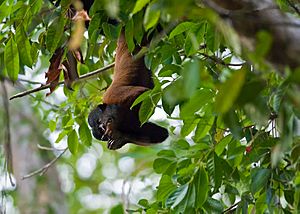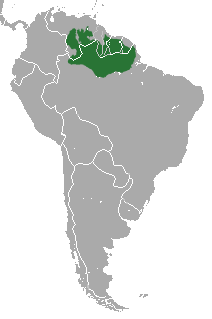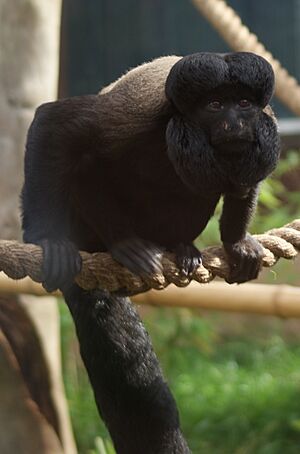Red-backed bearded saki facts for kids
Quick facts for kids Red-backed bearded saki |
|
|---|---|
 |
|
| C. chiropotes in Guyana | |
| Conservation status | |
| Scientific classification | |
| Genus: |
Chiropotes
|
| Species: |
chiropotes
|
 |
|
| Combined distribution of red-backed bearded saki and brown-backed bearded saki | |
The red-backed bearded saki (Chiropotes chiropotes) is a type of New-World monkey. It lives in South America and is known for its thick beard.
Contents
What They Look Like
The red-backed bearded saki has a very thick beard, especially the males. It also has a lot of hair on each side of its head. Its body is covered with dense fur. This fur can be red or yellowish-gold.
Their bushy tail is almost as long as their body. They cannot use their tail to grab things. Female sakis are usually smaller than males. Males are about 45 centimeters (18 inches) long. They weigh between 2.6 and 7.1 kilograms (5.7 to 15.7 pounds). These monkeys usually move on all four legs. However, they can stand up straight too.
Lifestyle and Habits
What They Eat
Red-backed bearded sakis mainly eat fruits. They also enjoy seeds, flowers, and nuts. Sometimes, they eat insects, larvae, and spiders. They can eat from about 100 different kinds of plants! Their teeth are special. They help the sakis crack open tough pods easily.
Daily Life
Chiropotes are diurnal primates. This means they are active during the day. They wake up at sunrise and go to sleep just before sunset. They live in groups of about 40 monkeys. Both male and female sakis are in these groups. Sometimes, the groups split into smaller parts. This happens when they travel or look for food. Finding food is their main activity.
Where They Live
You can find red-backed bearded sakis in Brazil, Venezuela, and the Guianas. They live north of the Amazon River. They are also found east of the Branco River.
Reproduction and Life Cycle
Female sakis give birth to one baby at a time. This happens after about five months of pregnancy. Babies are usually born during the rainy season.
Protecting Them
The International Union for Conservation of Nature (IUCN) says red-backed bearded sakis are not endangered. This means they are not at high risk of disappearing. However, people sometimes hunt them for their meat. There are 27 red-backed bearded sakis living in zoos around the world.
See also
 In Spanish: Sakí barbudo rojizo para niños
In Spanish: Sakí barbudo rojizo para niños



